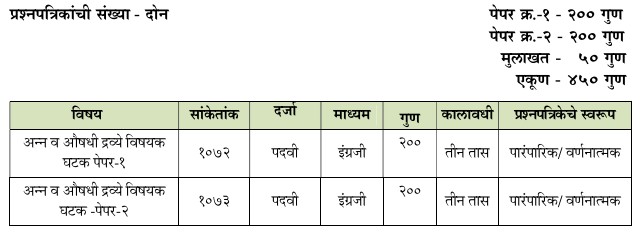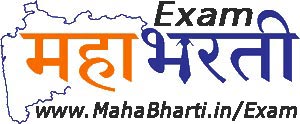Food and Drugs Administrative Service (Gazetted) Main Examination Syllabus PDF
सहायक आयुक्त (अन्न), गट-अ व अन्न सुरक्षा अधिकारी, गट-ब मुख्य परीक्षेचा अभ्यासक्रम
Food and Drugs Administrative Service (Gazetted) Main Examination Syllabus PDF – Maharashtra Public Service Commission recently Published Food and Drugs Administrative Service (Gazetted) Main Examination Syllabus for the post of Assistant Commissioner (Food), Group-A and Food Safety Officer, Group-B on the website of the Commission. Many candidates are serching For Food and Drugs Administrative Service Syllabus, here is a New Food and Drugs Administrative Service Syllabus and Exam Pattern PDF. Go through Food and Drugs Administrative Service Syllabus 2025 . In this article we have published Food and Drugs Administrative Service Mains Syllabus for Group A And Group B. As Soon as Commision Published Food and Drugs Administrative Service Prelims Syllabus We will Update on MahaBharti.in/exam Keep Visting this Page for More Updated MPSC Syllabus and Other details. Students can download Food and Drugs Administrative Service (Gazetted) Main Examination Syllabus PDF from below link :
 MPSC New Syllabus And Exam Pattern PDF-Download For All Exam
MPSC New Syllabus And Exam Pattern PDF-Download For All Exam
महाराष्ट्र लोकसेवा आयोगाने अलीकडेच सहाय्यक आयुक्त (अन्न), गट-अ आणि अन्न सुरक्षा अधिकारी, गट-ब या पदांसाठी अन्न व औषध प्रशासकीय सेवा (राजपत्रित) मुख्य परीक्षेचा अभ्यासक्रम आयोगाच्या वेबसाइटवर प्रकाशित केला आहे. अनेक उमेदवार अन्न आणि औषध प्रशासकीय सेवा अभ्यासक्रमासाठी शोध घेत आहेत, येथे नवीन अन्न आणि औषध प्रशासकीय सेवा अभ्यासक्रम आणि परीक्षा नमुना PDF आहे. अन्न आणि औषध प्रशासकीय सेवा अभ्यासक्रम 2025 द्वारे जा. या लेखात आम्ही गट अ आणि गट ब साठी अन्न आणि औषध प्रशासकीय सेवा मुख्य अभ्यासक्रम प्रकाशित केला आहे. आयोगाने अन्न आणि औषध प्रशासकीय सेवा प्रारंभिक अभ्यासक्रम प्रकाशित करताच आम्ही MahaBharti.in/exam वर अपडेट करू. तसेच महाराष्ट्र लोकसेवा आयोग Free Mock Test साठी येथे क्लिक करा
 To Know Latest Changes And Updates in MPSC Exam Click Here
To Know Latest Changes And Updates in MPSC Exam Click Here
Food and Drugs Administrative Service (Gazetted) Main Selection Process 2025
- Paper 1 – 200 Marks
- Paper 2 – 200 Marks
- Interview – 50 Marks
- Total -450 Marks
Food and Drugs Administrative Service (Gazetted) Main Exam Pattern 2025

Food and Drugs Administrative Service (Gazetted) Main Syllabus 2025
FAD Paper 1 Syllabus
| अ क्र | घटक |
|
Section – A : CHEMISTRY SYLLABUS |
|
| 1 | Periodic table/ Concepts of qualitative analysis
Periodicity of Elements: s, p, d, f block elements, the long form of periodic table. Effective nuclear charge, shielding or screening effect, Slater rules, variation of effective nuclear charge in periodic table, Atomic radii (van der Waals), Ionic and crystal radii, Covalent radii (octahedral and tetrahedral). |
| 2 | Bonding & Structure of organic compounds & their nomenclature
a) Hybridization: sp3, sp2, sp hybridization of carbon and nitrogen; sp3 and sp2 b) IUPAC nomenclature. Nomenclature of organic compounds: alkanes, alkenes, alkynes, |
| 3 | Mechanism of organic reactions Alkanals and Cycloalkanes
Alkanes and Cycloalkanes, Organic Reactions, Reactions of alkanes, Alcohols, and Amines, Nucleophilic Substitution, Formation of Alkenes and Alkynes. Elimination Reactions, Free Radical Addition and Substitution Reactions |
| 4 | Chemical calculations – Introduction to molecular spectroscopy
a) Chemical Calculations; Expressing concentration of solutions: Normality, molality, b) Molecular spectroscopy; Electromagnetic radiation, electromagnetic spectrum, |
| 5 | Chemical thermodynamics
a) Thermodynamic terms: System, surrounding, boundaries, open, closed and isolated system, intensive and extensive properties, state functions and path functions, zeroth law of thermodynamics |
| b) Thermo chemistry: Heats of reactions, standard states, enthalpy of formation of molecules, enthalpy of combustion and its applications, calculation of bond energy, bond dissociation energy and resonance energy from thermochemical data, Kirchhoff s equationc) First law of thermodynamics: concept of heat (q), work (w), internal energy (U), statement of first law, enthalpy, relation between heat capacities, sign conventions, calculations of heat (q), work (w), internal energy (U), and enthalpy (H) |
|
| 6 | Industrial Organic chemistry
Introduction to industrial organic chemistry, Industrial Organic Chemicals, Chemicals from ethylene, Chemicals from propylene, Chemicals from benzene, Toluene and Xylene (BTX Process), Chemicals from acetylene, Synthesis gas, Ammonia (Haber Process), Carbon monoxide, Sources of chemicals other than petroleum and natural Gas, Polymers, Plastics, Elastomers (Rubbers), Catalytic organic reactions. |
| 7 | Aromatic Hydrocarbons – haloarenes, phenols, ether and epoxides
Aromaticity: Introduction, Hückel’s rule, aromatic character of arenes, cyclic carbocations/ carbanions and heterocyclic compounds with suitable examples |
| Section – B : INTRODUCTION TO FOOD | |
| 1 | Constituents of food:
(i) Carbohydrates: Different carbohydrates such as starch, cellulose, sugars, pectin, fiber etc. and their significance in diet; Changes in carbohydrates during processing; Interaction of carbohydrates with other food constituents and their implications; Special application of carbohydrates in gels, emulsions, stabilization of food systems, etc. (ii) Proteins: Classification, Structure, Biological functions, Properties of proteins-denaturation, gelation, dough formation, foaming etc., Effect of processing on proteins, Amino acids-classification and properties, Peptides. (iii) Fats: Classification of lipids, Chemical aspects of fats-lipolysis, autoxidation, thermal decomposition, and chemistry of frying, Role of lipids in food flavor, Measurement of lipid oxidation-peroxide value, iodine value, TBA test, etc. (iv) Fibers: Classification, Physicochemical and functional properties |
| 2 | Food Nutrition: Nutritional aspects of foods, Relation of food and diseases, Nutritional requirement of special group of people, Effect of food processing on food nutrition. Structure and functions of Vitamins, Minerals, and other ME. |
| 3 | Food Safety: Types of hazards, Risk assessment, Existing and emerging pathogens. Microbial spoilage of foods, intrinsic factors, microbiology of fruits & vegetable, Meat, fish, sugar & sugar boiled products. Toxins in foods, Pesticides residues in foods, Heavy metals detection.
Food contaminants : Microbial, Chemical, Physical. Food adulteration: Common adulterants, simple tests for detection of adulteration. |
| 4 | Food Additives: Intentional and unintentional additives.
Additives used in food preservation such as preservatives, antioxidants, humectants etc. with respect to chemistry and food uses. Additives used as aids in food processing such as Sequestrant, emulsifier, hydrocolloids, non-nutritive sweet, artificial sweeteners, flavour enhancer stabilizers, anticaking and firming agents, flour bleaching and maturing agents, sweeteners, acidulants etc. and their functions in food processing and storage. Safety aspects of Food Additives: Tolerance levels & toxic levels in foods, Legal safeguard, Risks of food additives. |
| 5 | Food Packaging & labelling : Packaging types, Testing of various packaging materials and packages for evaluation of quality, Food and packaging material interactions including migration, scalping etc., Newer packaging technologies-VP/CAP/MAP; aseptic processing and packaging; active and intelligent packaging, Understanding labelling rules & Regulations, Nutritional labelling, Labeling requirements for pre-packaged food as per CODEX |
FAD Mains Paper 2 Syllabus
| अ क्र | घटक |
| Section – A : INTRODUCTION OF FOOD PROCESSING AND TECHNOLOGY | |
| 1 | Principles of food processing and preservation: Food processing and preservation techniques- Pickling, Drying and dehydration, Evaporation and concentration, Freezing, Chilling, Blanching, Pasteurization, Sterilization, UHT processing, Retort processing, Smoking, Curing, Canning, Bottling, Jellying, Food powders, Minimal processing, Photochemical processes, HPP, Hurdle technology, etc. |
| 2 | Technology of fruits and vegetables processing: Post-harvest technology; minimal processing; commercial canning of fruits and vegetables; processing and preservation of fruit beverages; processing of fruit preserves; commercial processing technology for value addition; artificial ripening. Carbonated fruits beverages, packaged drinking water. |
| 3 | Technology of plantation crops, herbs and spices processing: Processing of minor and major spices; extraction of spice oil and oleoresins; post-harvest processing of plantation crops; processing of medicinal and tuber crops. |
| 4 | Technology of meat, fish, poultry and egg processing: Meat processing & Preservation, egg processing and preservation; processing of fish and marine products |
| 5 | Technology of cereal processing: Grain storage principles; grain storage structures; wheat milling; paddy processing; parboiling and ageing of rice; barley malting; sorghum, Major & minor millets and oat processing; processing of cereals and millets for food uses. Baking technologies, Baking products, technology of extruded products. |
| 6 | Technology of legume and oilseed processing: Types of legumes and pulses; nutritional changes during soaking and sprouting of pulses, milling of pulses, methods used for removal of anti-nutritional compounds; oilseed processing. |
| 7 | Technology of milk and dairy processing: Recent dairy developments in India; sampling and quality testing of milk; processing technology of dairy products; dairy plant cleaning and sanitization operational details. |
| 8 | Confectionary and Snacks Technology: |
| 9 | Unit operations in foods processing: Cleaning, Sorting, Grading, mixing, centrifugation, crystallization, size reduction, membrane separation. |
| Section – B : NATIONAL/INTERNATIONAL/CODEX STANDARDS | |
| 1 | National/International standards: Food Safety and Standards Act, 2006; Structure of FSSAI, Administrative set up at state level, Roles and responsibilities of different food safety regulators, Licensing and Registration, Codex of practice, Guidelines and recommendations, Applying Codex standards, Codex India-Role of Codex Contact point, National Codex Contact Point (NCCP). Core functions of NCCP-India, WTO, WHO, FAO, SPS, TBT etc. |
| Section – C : EMERGING TECHNOLOGIES IN FOOD PROCESSING | |
| 1 | Emerging Food:
Organic food: Production, processing and regulation, Organic certification process, Organic food labelling, etc. GM food: Production, processing and regulation, Main issues of concern for Human Health, How are GM Food regulated Internationally, Regulation in India. Role of WHO to improve evaluation of GM food, Benefits & Controversies. Irradiated Food: How is food Irradiated, Sources of radiations used, Potential uses of Food Irradiation, Labelling of Irradiated Food, Doses of irradiation. Functional Foods and Nutraceuticals : Functional foods from plant and animal sources, Nutraceuticals, Dietary supplements, Regulation. Food Fortification: Fortification with micronutrients, Bio fortification, Current mandatory fortifications, Fortification strategies and practices, Health implication of food fortification. |
| 2 | Emerging Processing Technique*: Ohmic healing. Microwave healing. RF heating, lll’l’. i’1.1. Ultrasound. Hydrodynamie caviialion. Cold plasma. UV irradiation. Pulsed Light etc. |
| i | Emerging Analytical Techniques: Spectroscopic (UV. IK. W’K. Mass. Raman) and Chromatographic |TLC. HPLC. HPTLC. GC). |
| Scciinn – 1) : OTHER RELATED ACTS. | |
| 1 | B.I.S (Bureau of Indian Standards) |
| 2 | C.R.P.C/LP.C. |
| 3 | CC( Essential Commodities Act) |
| 4 | Consumer Protection Act. |

